77 F. maximum temperature yesterday in the Twin Cities.
83 F. average high on June 29.
81 F. high on June 29, 2016.
June 30, 1982: Frost hits St. Louis County. Kulger Township falls to 27 degrees and Meadowlands bottoms out at 32.
June 30, 1871: Extremely large hail falls in Meeker County. Some of the stones are 6 inches in circumference, breaking many windows on the north sides of houses.
A Better Than Average 4th of July Weekend Outlook
"All we have of freedom, all we use or know — This our fathers bought for us long and long ago" wrote Rudyard Kipling. My father survived Hitler and Stalin, and built a new life in the USA. He once told me that many Americans take their freedom for granted. "I will never, ever take my freedom for granted" he told me many years ago.
Meteorologists in this country have the freedom to disagree with the official (NOAA) forecast. We can look
at the models, interpret what we see, and try to improve on the government forecast. Try that in other countries and you can wind up in jail.
T-showers bubble up again today (what a shock) but much of Minnesota will be dry over the weekend, with
highs in the 70s to near 80F.
"All we have of freedom, all we use or know — This our fathers bought for us long and long ago" wrote Rudyard Kipling. My father survived Hitler and Stalin, and built a new life in the USA. He once told me that many Americans take their freedom for granted. "I will never, ever take my freedom for granted" he told me many years ago.
Meteorologists in this country have the freedom to disagree with the official (NOAA) forecast. We can look
at the models, interpret what we see, and try to improve on the government forecast. Try that in other countries and you can wind up in jail.
T-showers bubble up again today (what a shock) but much of Minnesota will be dry over the weekend, with
highs in the 70s to near 80F.
The
leading edge of sauna-like heat and humidity may spark stray T-storms
over southern Minnesota Monday and Tuesday, but most of the time will be
dry, with a touch of humidity in the air.
As
I've been warning for a few days - guidance hints at 90s by the end of
next week. Our welcome reprieve from heat is coming to an end. Get ready
for a hot and steamy Dog Day July!
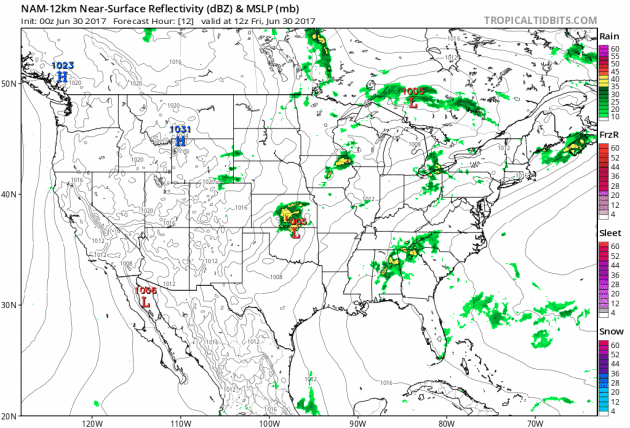
Real-time wildfire map above: ESRI.com.
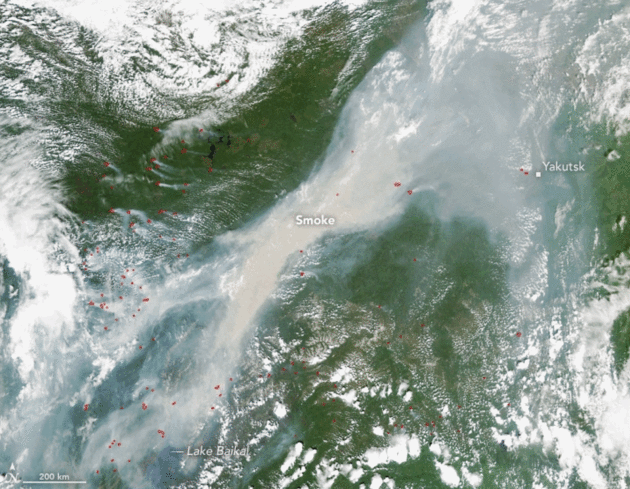
These NASA Images Show Siberia Burning Up. Climate Central has details: "Siberian wildfire season is off and running with multiple blazes searing the boreal forest and tundra. It's the latest example of the vast shifts happening to the forests that cover Siberia and the rest of the northern tier of the world as climate change alters the landscape. Those forests are burning at a rate unheard of in at least 10,000 years due largely to rising temperatures. They contain vast reserves of carbon stored in trees and soil and when they burn, they send that carbon into the atmosphere. That creates a dangerous cycle of more severe wildfires and ever rising temperatures..."
Photo credit: "A satellite image captured on June 23, 2017 shows the extent of wildfires burning across Siberia." Credit: NASA Earth Observatory.
Lightning-Caused Fires On The Rise in the World's Largest Forest. National Geographic reviews new research: "As fire season reaches for its annual summer turning point, the role lightning plays as the culprit in setting fires shows a worrisome trend. That’s not good news for the boreal forest, the world’s largest forest habitat, where virtually all wildfires are ignited by lightning. Since 1975, the number of fires ignited by lightning has increased between two and five percent, driven by an increase in volatile thunderstorm weather, according to a new NASA study published Monday in Nature Climate Change. In two of the last three years, immense fires in Alaska and Canada’s Northwest Territories provided a good case study, says Sander Veraverbeke, the study’s lead author and an Earth scientist at Vrije Universiteit Amsterdam..."
Photo credit: "This forest fire was caused by lightning, and the problem seems to be on the rise since 1975." Photo by Mark Thiessen, National Geographic Creative.
Siberian
wildfire season is off and running with multiple blazes searing the
boreal forest and tundra. It’s the latest example of the vast shifts
happening to the forests that cover Siberia and the rest of the northern
tier of the world as climate change alters the landscape.
Those forests are burning at a rate unheard of in at least 10,000 years
due largely to rising temperatures. They contain vast reserves of
carbon stored in trees and soil and when they burn, they send that
carbon into the atmosphere. That creates a dangerous cycle of more
severe wildfires and ever rising temperatures.Map credit: "GFS weather model analysis of maximum temperatures in the Middle East Thursday afternoon." (WeatherBell.com).
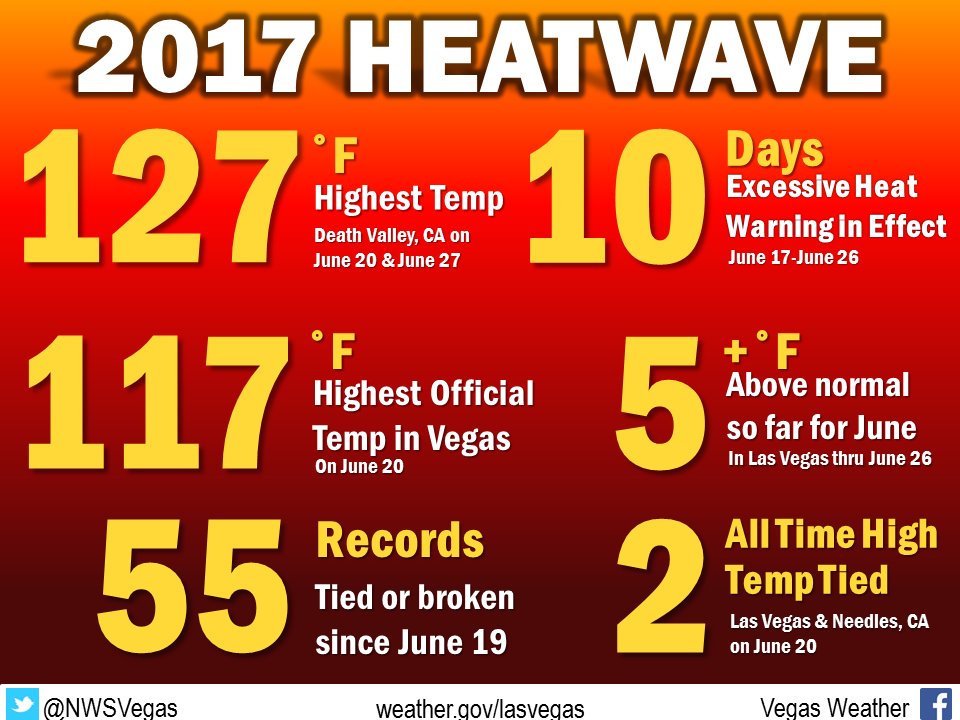
A Steamy June, Nationwide. Here's an excerpt from Planalytics: "June 2016 was one of the warmest on record in the U.S. Across most eastern markets, it was also the driest June in five years or more. This boosted overall traffic levels and sales of summer products. This June's cooler and rainier conditions (compared to 2016) will negatively impact comp sales performance for many retailers and restaurants. The less favorable weather is projected to cost restaurants $447 million in sales vs. June 2016. Apparel chains face a $106 million headwind..."
Weather Whiplash. The graph above shows CEI, Climate Extreme Index, the percentage of the USA in extreme drought or flood since 1910, courtesy of NOAA NCEI.
Photo credit: "A file picture dated 13 April 2010 shows a boy from Senegal walking along a polluted beach strewn with predominantly plastic bottles in the village of Ngor, Dakar, Senegal." Photograph: Nic Bothma/EPA.
Graphic credit: "This false-color image shows ozone concentrations above Antarctica on Oct. 2, 2015." (Credits: NASA/Goddard Space Flight Center).
EPA Chief Met With Dow CEO Before Deciding on Pesticide Ban. Associated Press reports: "...EPA released a copy of Pruitt’s March meeting schedule earlier this month following several Freedom of Information Act requests. Though his schedule for the intervening months has not yet been released, Bowman said Pruitt has had no other meetings with the Dow CEO. There was a larger group meeting that Pruitt attended which also included two other Dow executives, but she said that didn’t involve chlorpyrifos. Dow, which spent more than $13.6 million on lobbying in 2016, has long wielded substantial political power in the nation’s capital..."
Minnesota's Second 100-Megawatt Solar Project Is Up and Running. Star Tribune reports: "One
of the largest solar energy initiatives in Minnesota, the Aurora
project, has been completed, its owner said Tuesday. The Aurora project
features 16 separate solar power plants in Minnesota that together will
provide electricity to Xcel Energy under a long-term contract. Aurora,
which cost $290 million, is owned by Enel Green Power North America and
can produce 100 megawatts of power, enough for more than 17,000 homes. A
megawatt is 1 million watts..."
Image credit: SUMR.
Photo credit: "A United Parcel Service (UPS) truck on delivery is pictured in downtown Los Angeles, California October 29, 2014." REUTERS/Mike Blake.
A Bonkers Private "Jet" Brings Electric Flight to the Rich. A story at WIRED.com made me do a double-take: "If you’re just coming around to the idea of battery powered cars, prepare for the next onslaught, because the future of flight
is electric too. And just as with ground vehicles, nothing pushes along
new tech like some sex appeal. Tesla did that for cars, with sleek
looks and ludicrous acceleration. Now, Eviation Aircraft wants to do the same for the sky. At last week's Paris Air Show, the Israeli company unveiled a prototype electric light aircraft, a private jet without the jet engines..."
Photo credit: Eviation Aircraft Ltd.
Image credit: SpaceX.

Robocalypse Now? Central Bankers Argue Whether Automation Will Kill Jobs. The short answer appears to be - yes. Here's an excerpt from The New York Times: "...Generally speaking, economic growth is a good thing,” Ben S. Bernanke, former chairman of the Federal Reserve,
said at the forum. “But, as recent political developments have brought
home, growth is not always enough.” In the past, technical advances
caused temporary disruptions but ultimately improved living standards,
creating new categories of employment along the way. Farm machinery
displaced farmworkers but eventually they found better paying jobs, and
today their great-grandchildren may design video games. But artificial
intelligence threatens broad categories of jobs previously seen as safe
from automation, such as legal assistants, corporate auditors and
investment managers. Large groups of people could become obsolete,
suffering the same fate as plow horses after the invention of the
tractor..."
Photo credit: "Employees
of the German online retailer Zalando preparing customer orders for
shipping in Erfurt, Germany. Zalando has invested heavily in hubs like
the one in Erfurt and increased automation." Phil Hatcher-Moore for The New York Times.
Photo credit: "Pyrosomes aboard a National Oceanic and Atmospheric Administration research vessel in the Pacific Ocean off the coast of Oregon in May." (Hilarie Sorensen/NOAA Fisheries via Reuters).


TODAY: Showers and T-storms. Winds: NW 5-10. High: 75
FRIDAY NIGHT: Showers slowly taper. Low: 60
SATURDAY: Partly sunny, a drier day. Winds: NW 8-13. High: 74
SUNDAY: Mix of clouds and sun, a bit milder. Winds: N 5-10. Wake-up: 62. High: 79
MONDAY: Some sun, stray T-storm possible. Winds: SE 5-10. Wake-up: 61. High: 81
4TH OF JULY: Sunny start, late-day pop-up T-storm. Winds: SE 7-12. Wake-up: 63. High: 84
WEDNESDAY: Hot sun, noticeable heat index. Winds: SE 7-12. Wake-up: 65. High: 88
THURSDAY: Steamy sunshine, Dog Days are back. Winds: S 10-15. Wake-up: 66. High: 91
Climate Stories...
Map credit: New York Times. Kopp, Hsiang, et al. / Science.
Climate Change is Already Hitting Home. It's not something that's 30 years down the road - we're already seeing symptoms of a warmer, wetter world, including more extreme rainfall events, worldwide. Here's an excerpt of a post from Popular Science and Peter Sinclair at Climate Denial Crock of the Week: "...According to a recent Yale survey, 7 in 10 Americans believe global warming is real and happening. And 6 in 10 believe it is affecting U.S. weather. But only 1 in 3 say they’ve personally felt its effects. That disconnect stuck with Heidi Cullen. “You’re never going to think of it as an issue that’s urgent unless you recognize the fact that you’re already being impacted,” says Cullen, chief scientist for the nonprofit Climate Central. Now in its ninth year, Climate Central is part research hub and part journalism outfit—an unusual hybrid that tries to connect climate change to people’s lives. The organization’s latest project, World Weather Attribution, identifies direct links between extreme weather events and global warming. Cullen and her team created the program after realizing that while the tools for attributing such events have evolved, the results were coming out too late to influence the conversation..."
Researchers published a landmark study in Science
on Thursday that analyzes what climate change will mean for the
economies of all 3,144 counties in the U.S. The analysis is the first of
its kind, but the results show what’s becoming a common refrain when it
comes to the impact of climate change: Rising temperatures will cause
the poorest to suffer the most, even in the wealthiest nation in the
world.
Union County is just one of a host of poor counties in the
South that will be hit disproportionately hard by the impacts of climate
change. In contrast, more wealthy counties in the northern third of the
country are likely to be insulated from the effects of climate change
and could even make economic gains because of new agricultural land
opening up and fewer deaths due to cold weather. The findings have broad
implications for county planning and the need for a strong, coordinated
response to address climate change at the national level.
Researchers published a landmark study in Science
on Thursday that analyzes what climate change will mean for the
economies of all 3,144 counties in the U.S. The analysis is the first of
its kind, but the results show what’s becoming a common refrain when it
comes to the impact of climate change: Rising temperatures will cause
the poorest to suffer the most, even in the wealthiest nation in the
world.
Union County is just one of a host of poor counties in the
South that will be hit disproportionately hard by the impacts of climate
change. In contrast, more wealthy counties in the northern third of the
country are likely to be insulated from the effects of climate change
and could even make economic gains because of new agricultural land
opening up and fewer deaths due to cold weather. The findings have broad
implications for county planning and the need for a strong, coordinated
response to address climate change at the national level.
A Giant Iceberg Is About to Break Off From Antarctica. Details at Fortune: "A
massive iceberg is “hours, days, or weeks” away from separating from
Antarctica’s Larsen C ice shelf, scientists based in the United Kingdom said Wednesday.
“When it calves, the Larsen C Ice Shelf will lose more than 10% of its
area to leave the ice front at its most retreated position ever
recorded," the scientists wrote. "This event will fundamentally change
the landscape of the Antarctic Peninsula." The iceberg that forms from
the predicted separation could end up being roughly the size of
Delaware, making it one of the largest icebergs
that scientists have ever observed. The event could trigger a collapse
of the entire Larsen C ice shelf, a catastrophe that could raise
worldwide sea levels by four inches, researchers estimate..."
Image credit: Project Midas.
"Comparison of speeds between Sentinel-1 image mosaics in early and
late June 2017. The early mosaic combines displacements on the inner
shelf measured between 6th and 12th June with similar ones on the outer
shelf measured between 3rd and 15th June. The recent mosaic combines
inner shelf displacements up to 24th June with outer shelf displacements
only 3 days later highlighting a significant acceleration over those
three days."
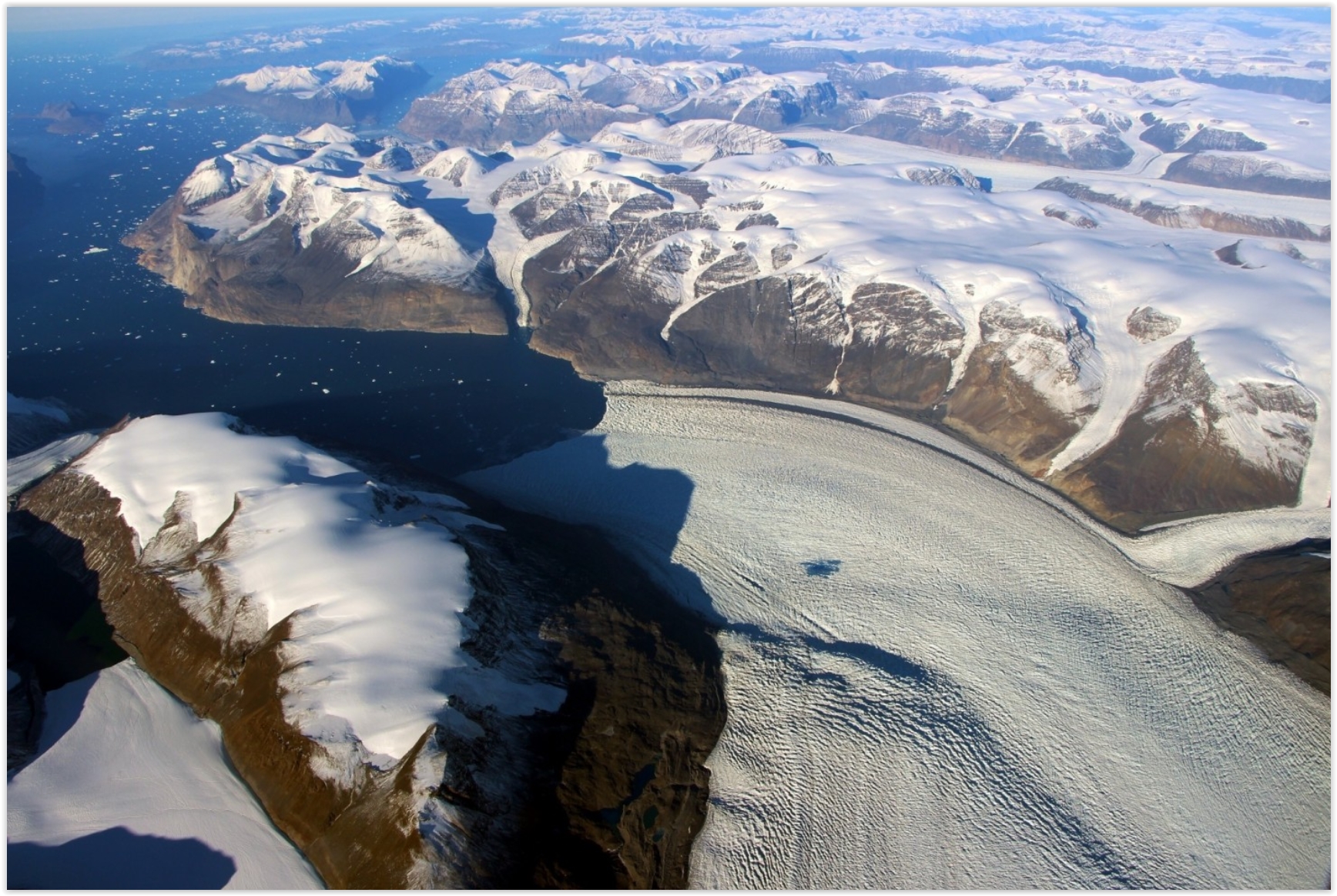
Climate Change is Not The Only Cause of Greenland Ice Melt. Blame Sunnier Days. My first reaction: what's causing the sunnier days? Here's an excerpt from Newsweek: "Greenland’s ice sheet is melting faster than expected, and this has been accelerating over the past two decades. It is now the biggest single contributor to global sea level rise, accounting for 25 percent of the total. But besides warming climes, there is another culprit for the melt: sunnier days in fair Greenland. A paper published June 28 in the journal Science Advances shows that cloud cover has decreased by 14 percent from 1994 to 2009, at an average of just under 1 percent per year. That may not sound like much, but for ice, it’s a big deal. The researchers show that for every 1 percent drop in cloud cover, the amount of ice melt has increased by 27 gigatons. That’s a vast amount of water, approximately equivalent to the domestic water supply of the United States..."
File photo credit: John Sonntag, NASA.
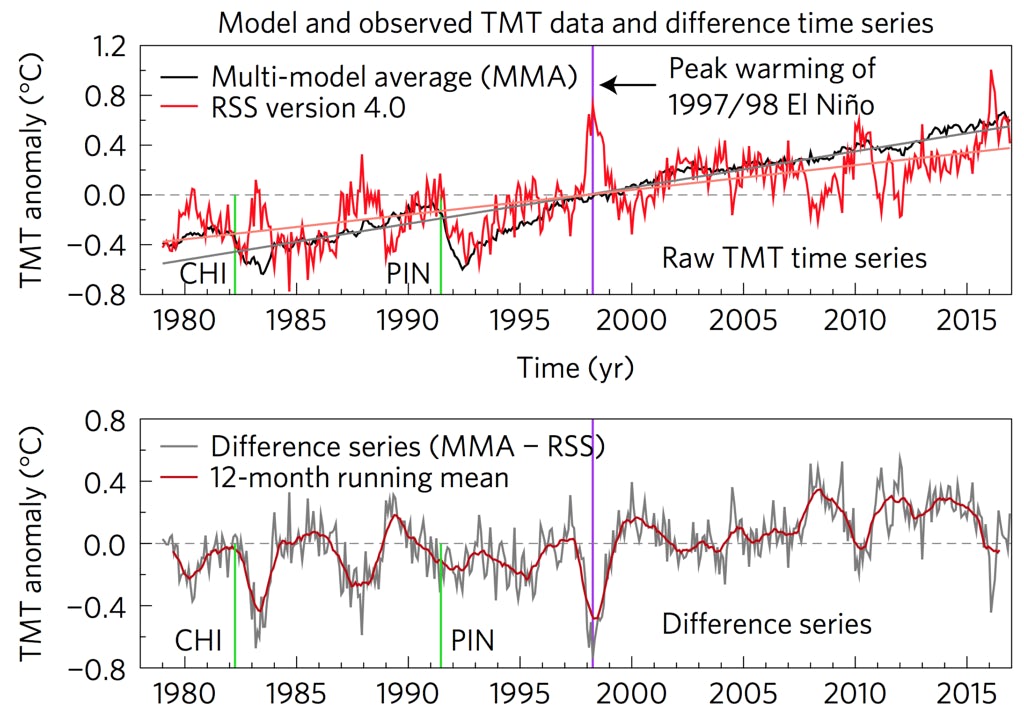
Climate Scientists Just Debunked Deniers' Favorite Argument. Here's a clip from an explainer at The Guardian: "...In a new study, a team climate scientists led by Ben Santer sought to answer this question. They effectively disproved Christy’s assertion that the discrepancy was due to models being too sensitive to the increased greenhouse effect. Instead, the main culprit seems to be incorrect inputs used in the climate model simulations. The issue is that climate model simulations are run using specific scenarios. These scenarios assume specific changes in factors that influence global temperature and climate changes (known as “forcings”), like rising levels of atmospheric greenhouse gases and changes in solar and volcanic activity. Climate models don’t make “predictions;” rather, they make “projections” of how temperatures and other climatological factors will change in response to those forcing input scenarios. There’s also a random component known as “internal variability” due to factors like unpredictable ocean cycles..."
Graphic credit: "Remote Sensing Systems estimate of the temperature of the middle troposphere compared to the CMIP5 multi-model average (top frame), and the difference between the two over time (bottom frame)." Illustration: Santer et al. (2017), Nature Geoscience.
Crossing an Ideological Divide. Full disclosure: EEN President and former Methodist minister Mitch Hescox is my co-author for the book "Caring for Creation": The Evangelical's Guide to Climate Change and a Healthy Environment." Here's an excerpt of an Op-Ed at The York Dispatch: "...So it was more than a tad refreshing to hear a local conservative weigh in this month in favor of acting on climate change. Mitchell Hescox, president of the York-based Evangelical Environmental Network, said in an essay he penned for the Dispatch that his organization is “part of a growing number of faith-based, bipartisan and conservative groups dedicated to caring for our children’s health by being good stewards of the earth.” He has no trouble reconciling science and religion: “Left unchecked, CO2 levels will continue to rise beyond the over 400 (parts per million) that God intended,” he writes. And he has no trouble reconciling science and political affiliation. Hescox calls on Christians of all political parties to be “good stewards of the earth...”
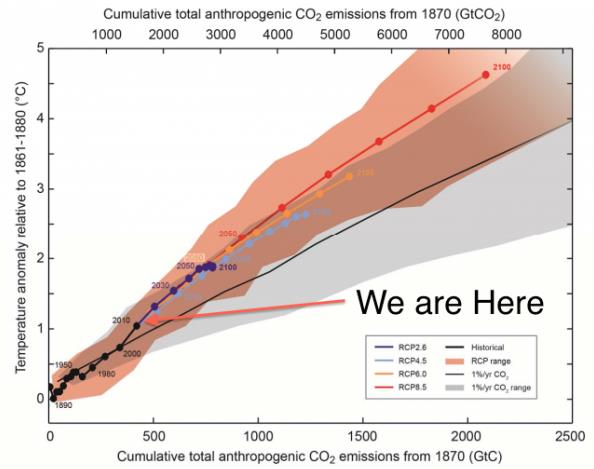
Three Years to Ward Off Potential "Climate Catastrophe"?
I realize the situation is urgent - we don't know what we don't know,
and tipping points are inevitable. I do get a little leary about some of
the more strident gloom and doom headlines though, some people just
shut down or avoid the topic when they see things like this. We don't
have much time, but whether it's 3 years or 15 years - I don't pretend
to know. Here's an excerpt from The Verge: "To
save world from the climate change apocalypse, we need to start cutting
greenhouse gas emissions by 2020, a group of scientists claims. We have
just three years to do this, or the planet will warm to levels that
kick off irreversible, catastrophic climate changes. To help avoid the
worst-case scenario, the scientists set six milestones to reduce carbon
emissions across sectors, including energy, transportation, and
infrastructure. The goals range from expanding renewables to reducing
deforestation, to issuing “green bonds” to finance climate-mitigation
efforts. This position paper appears in the journal Nature, just ahead of a meeting of world leaders in Hamburg, Germany..."
Pentagon, Trump Are At Odds on Climate Change - and Democrats Are Taking Advantage. The Miami Herald reports: "...Scientists estimate that rising sea levels threaten at least 128 U.S. military bases and installations, nine of which are major hubs for the U.S. Navy. Military installations on waterfront properties are facing hundreds of floods a year, and some could be mostly submerged by 2100, according to a report from the Union of Concerned Scientists. Military leaders have consistently warned that extreme weather patterns, drought and floods are aggravating social tensions, destabilizing regions and feeding the rise of extremist groups like al Qaida and the Islamic State. At his confirmation hearing, Secretary of Defense Jim Mattis called climate change a “driver of instability” that requires a “whole-of-government response” to address..."
Photo credit: "Army National Guard vehicles travel through floodwaters Aug. 14, 2016, on LA-442, west of Tickfaw, La., as rescue operations continue after heavy rains inundated the region." Max Becherer AP.
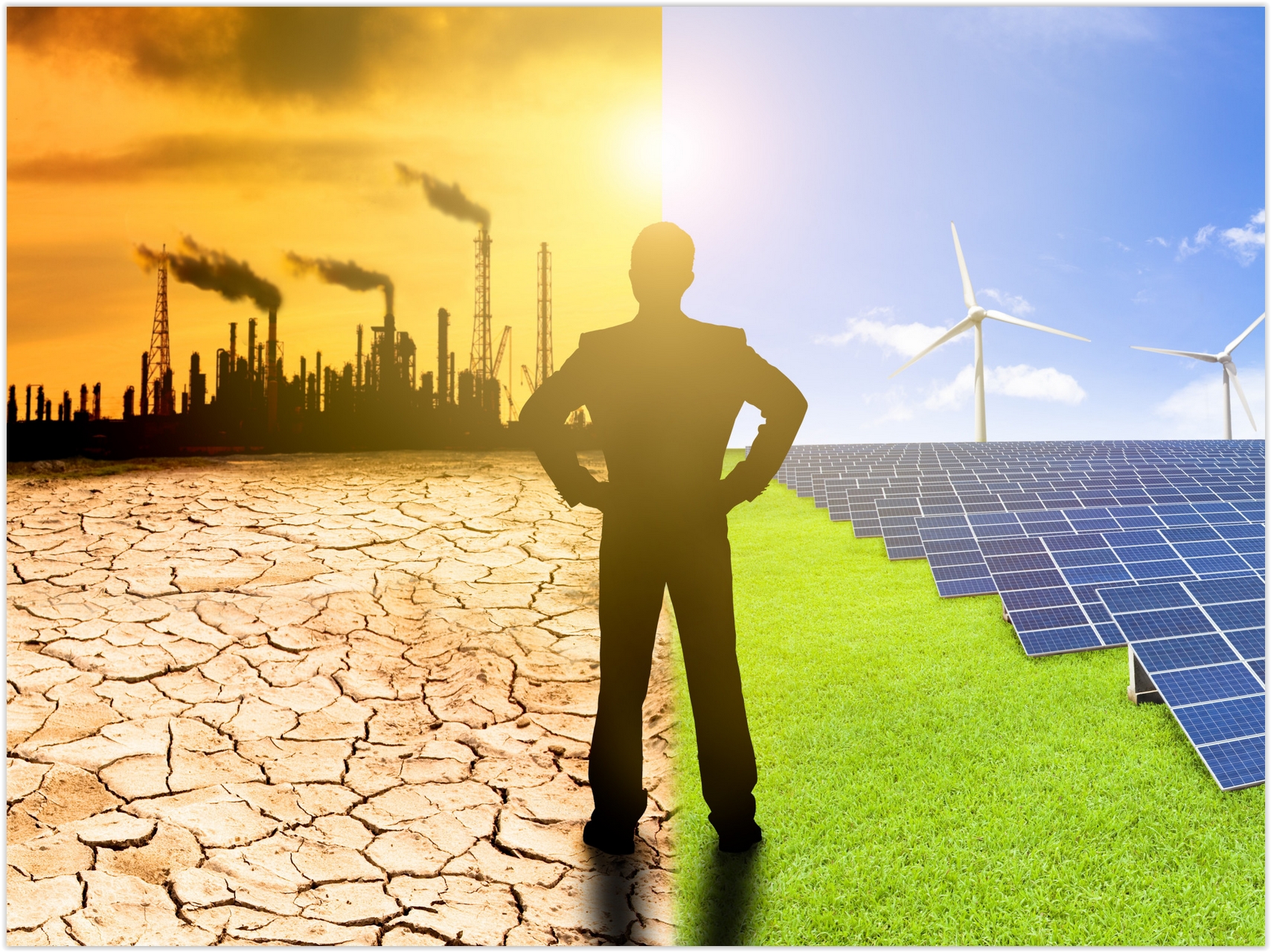
Make Climate Change Bipartisan Again. As recently as 2007 there was little disagreement between Republicans and Democrats about the threat (and opportunity) posed by rapid, man-made climate change. But today the science has been swept up into a partisan political food-fight, argues an Op-Ed at The Tennessean: "...An approach that can find common ground between Republicans and Democrats is “carbon fee and dividend,” whereby a steadily rising fee is placed on fossil fuels, with the revenue returned to consumers. The fee sends a powerful price signal to the marketplace to speed up the transition to a clean-energy economy. Returning revenue to households will shield families from the impact of rising energy costs associated with the fee. To protect American businesses, a border adjustment tariff would be applied to imports from nations that do not have an equivalent price on carbon, providing a strong incentive for countries to follow our lead with a similar policy. Regional Economic Models found that, after 20 years, carbon fee and dividend would reduce emissions 50 percent while adding 2.8 million jobs to the economy..."
File image: TechCrunch.
Climate Change is an Energy Problem, So Let's Talk Honestly About Nuclear. Until we can get clean, renewable energy at scale, we still need nuclear to provide a carbon-free source of energy. An Op-Ed at The Guardian has food for thought: "...Clearly then, we urgently need a nuanced discussion on our energy future to stave off the worst ravages of climate change. Yet too often this falls at the first hurdle; with old battle-lines long drawn, nuclear advocates and opponents hold their own courts, talking only to their own side and dismissing the criticism and concerns of the other. These echo chambers may be comforting, but they are ultimately detrimental to our collective wellbeing. With the chaos of climate change on our doorstep, it has never been more imperative that we make informed decisions about how best to power our world. For progress to occur, both sides need to heed each other and have an honest conversation about the advantages and risks of all forms of energy production..." (File image: Shutterstock).
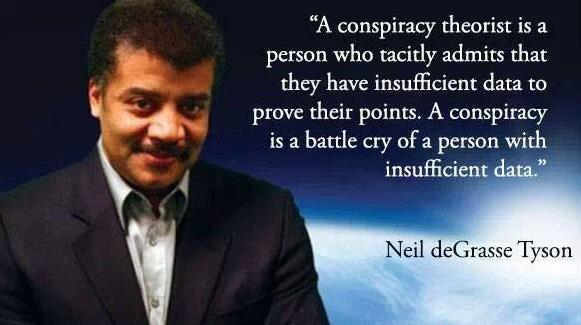

No comments:
Post a Comment